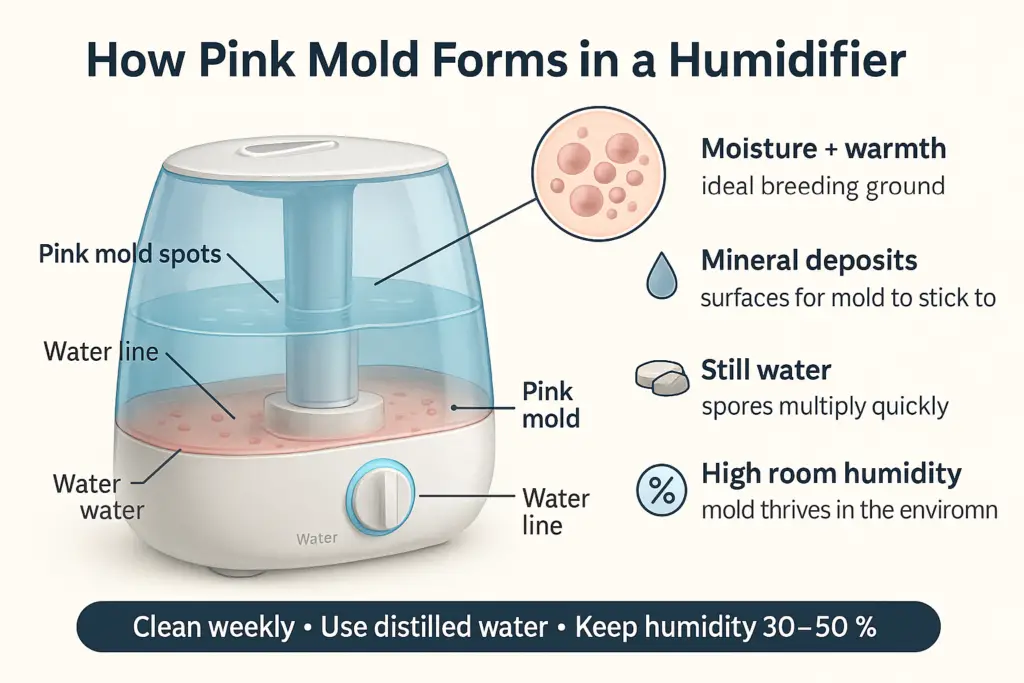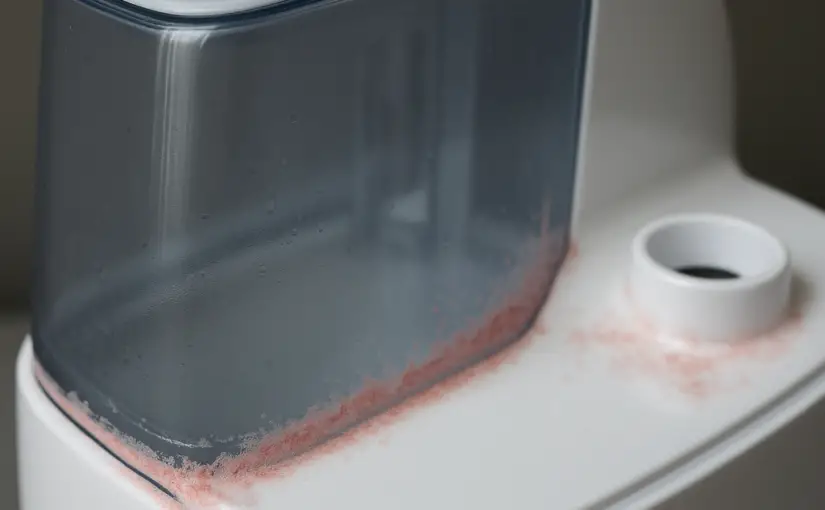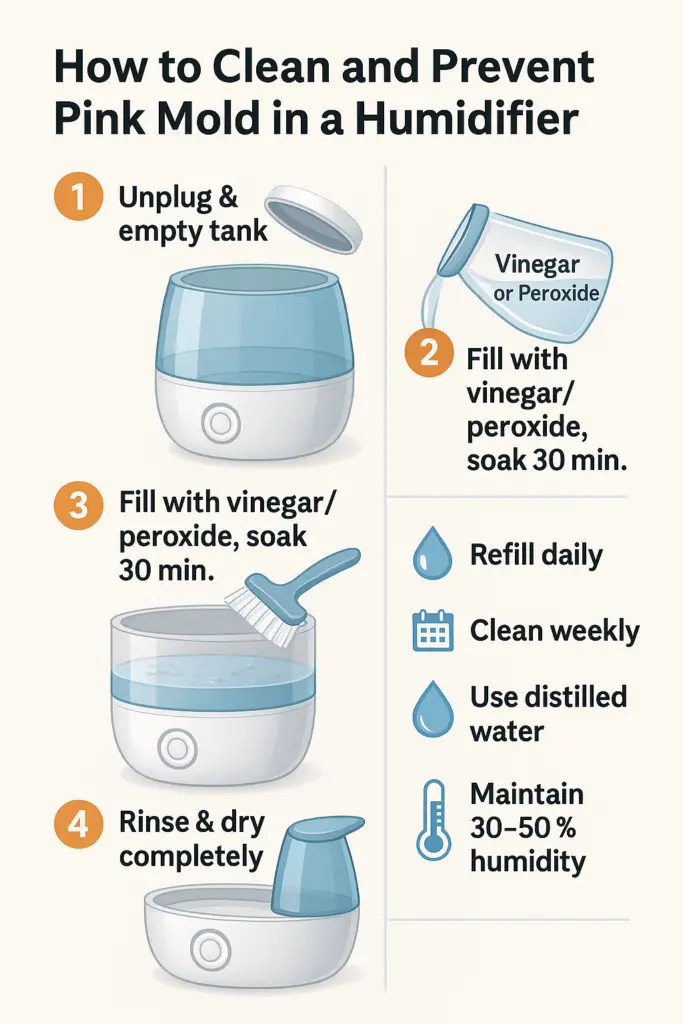Is pink mold in a humidifier dangerous?
Yes — it can be, especially for people with allergies, asthma, or weakened immune systems. The microbes behind the pink film (often Serratia marcescens bacteria or the yeast‑like fungus Aureobasidium pullulans) can irritate the lungs, skin, and eyes, and may contribute to infections with repeated exposure. The good news is it’s common, very fixable with a thorough clean, and preventable once you dial in your humidity and maintenance routine.
Table of Contents
What Pink Mold in a Humidifier Looks Like (and What It Really Is)
Open the tank to top off water and you see it: a salmon‑pink film, maybe a slick ring near the waterline, or a faint stain around the mist outlet. It’s not your humidifier “going bad,” and you don’t need to throw it out. That color usually points to microbes that love damp, mineral‑rich places — exactly what a warm water tank provides. A quick reset (clean, dry, refill) clears it, and a couple of smart habits keep it from returning.
 Why you’re seeing pink mold now
Why you’re seeing pink mold now
Pink growth is more likely when indoor air stays moist for long stretches and water sits in the tank between refills. Minerals in tap water leave a light scale that microbes can cling to. If your unit has been running a lot, or the room feels a little “clammy,” your home might simply be running too humid — and the humidifier tank is where that shows up first.
Think of pink mold as a friendly warning flag. It’s your cue to check the broader humidity picture in the room and adjust before the problem spreads beyond the tank.
Do a quick humidity check (takes 30 seconds)
If you have a hygrometer, glance at it. The healthy target is 30–50% relative humidity. When readings sit above 55–60% for hours at a time, you’ve created great conditions for mold and bacteria — in the tank and around the house.
No meter handy? Look for simple clues: persistent condensation on windows, a faint musty smell, towels that don’t quite dry, or allergies that seem worse when the humidifier runs. Any of those point to “a little too damp.”
Easy ways to nudge humidity back into the sweet spot
You don’t need a renovation — just a few friendly habits:
Let fresh air help. On mild days, crack a window for 10–15 minutes; moving air pulls excess moisture out. Use bathroom and kitchen exhaust fans during showers and cooking.
Give the humidifier breaks. If you’re over 45–50% RH, pause the unit or lower its setting. Many models don’t need to run 24/7.
Consider a dehumidifier. Basements and tightly sealed rooms benefit from occasional drying cycles, especially after storms or laundry days.
Use distilled water. Fewer minerals mean less residue on tank walls — and fewer places for pink film to get started.
Right size matters (so you don’t over-humidify)
A humidifier that’s too large for the room can overshoot your target quickly and keep the air damp — exactly what pink mold prefers. Matching output to room size prevents “tropical” conditions and makes maintenance easier. If you’re not sure your unit is a fit, here’s a simple guide:
How to choose the right size humidifier for your room.
 Okay — how do I get the pink out right now?
Okay — how do I get the pink out right now?
Here’s a gentle, effective clean that most manufacturers are happy with:
1) Power down and empty. Unplug, remove the tank, and pour out any water.
2) Soak to loosen. Fill the tank with white vinegar or 3% hydrogen peroxide and let it sit for about 30 minutes. This softens residue and disrupts the biofilm.
3) Light scrub. Use a soft brush or toothbrush to reach seams and corners. Avoid abrasive pads that can scratch the plastic (scratches give microbes hiding spots).
4) Rinse thoroughly. Warm water rinse until you no longer smell vinegar or peroxide.
5) Dry completely. Air‑dry parts on a clean towel before reassembly so you’re not trapping moisture in crevices.
Tip: Skip bleach unless your manufacturer specifically recommends it — it can pit plastics and leave fumes you don’t want to inhale.
Simple habits that keep pink mold from coming back
Refresh daily. Don’t let water sit in the tank more than 24 hours. A quick dump and refill knocks down growth dramatically.
Weekly reset. Do the soak‑and‑rinse routine once a week during heavy use. It takes about the length of a TV episode and pays back all season.
Mind the minerals. Distilled water reduces scale (less “grip” for microbes). If you stick with tap, clean a touch more often.
Optional helpers. Some people like a drop or two of tea tree oil or a labeled “humidifier treatment” tablet; use sparingly and only if your manual allows additives.
When to consider replacing the unit
If pink film returns immediately after a proper clean, or the tank has deep scratches and permanent staining, replacement may be cheaper (and safer) than battling hidden biofilm. Motors and misters last longer — and run quieter — when the water path is clean.
The bigger picture: a healthy home humidity rhythm
Humidifiers shine when they take the edge off dry winter air — preventing nosebleeds, easing coughs, and protecting wood furniture — without pushing your home into the soggy zone. Keep an eye on that 30–50% range, size the unit to the room, and give the tank a weekly reset. Do that, and pink mold tends to become a non‑issue.
Want a broader, step‑by‑step overview that covers types, setup, safety, and maintenance? Dive into our
Complete Humidifier Guide
for clear tips you can use today.
Quick answers to common questions
Is pink mold the same as black mold?
No. Pink growth is most often Serratia marcescens (a bacteria) or Aureobasidium species (yeast‑like fungus). It’s generally less hazardous than black mold but still irritating — especially with repeated exposure. Treat it seriously, clean it fully.
Can I keep using the humidifier while there’s pink film?
Pause it, clean it, then resume. Running through the film can aerosolize contaminants and worsen irritation or allergies.
What humidity should I aim for?
30–50% RH is the comfort and health sweet spot for most homes. If you’re consistently above 55–60%, reduce runtime, ventilate, or use a dehumidifier until the reading drops.
Will a bigger humidifier fix dry air faster?
It will — but it’s easier to overshoot and end up damp. For steady comfort without pink mold, match capacity to your room:
humidfier sizing guide.
Bottom line
Pink mold in a humidifier is a nudge, not a nightmare. Clean the tank thoroughly, keep your indoor humidity in the 30–50% range, and make sure your unit is sized for the space. With those pieces in place — and a quick weekly reset — you’ll keep the pink film away and your air comfortably healthy. For deeper how‑tos and setup tips, explore the
Humidifier Guide.


 Okay — how do I get the pink out right now?
Okay — how do I get the pink out right now?


